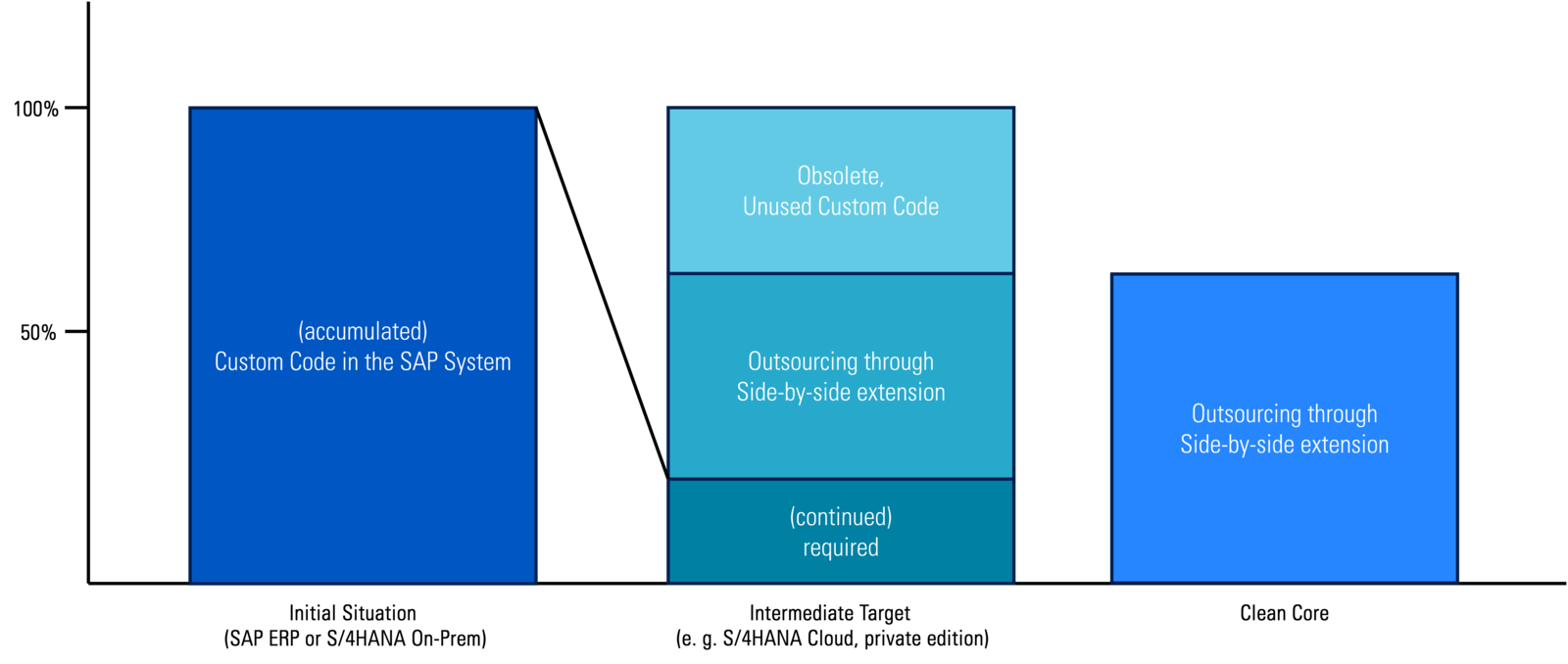How to Achieve Clean Core:
Cloud Strategy Sets the Course
Many SAP customers on the verge of migrating to S/4HANA are asking themselves the following question: What will happen to our custom developments? Our advice: In any case, it is worth investing in clean core. Your own objective and cloud strategy will determine which approach is right for you.
For a long time now, many SAP user companies have used their SAP ERP system not only to map standard processes and functions, but also as a development platform. The user/customer exits available in ABAP, the enhancement framework, BADIs (Business Add-Ins), BAPIs (Business Application Programming Interfaces), modifications, and so on offer comprehensive enhancement options to easily customize the standard SAP system – integrated with access to all available SAP data.
Generally, this is not done for the fun of programming, but rather because a company needs to map or expand the unique selling proposition or their own competitive advantage through the use of customized digital processes. Consequently, several thousand lines of custom code, customer-specific objects, modifications – and therefore also numerous technical "corpses" – have accumulated over time. In the ABAP world, old, revised and obsolete source code is very rarely deleted. Instead, it is usually carried along for years and years.
Most SAP user companies now face the challenge of having to migrate an SAP ERP system, which has been optimized and expanded over the years to meet their own needs, to S/4HANA. As a result, they are asking themselves whether, and to what extent, a cleanup of customer-specific enhancements in their system is necessary. The experts believe that the cloud strategy favored by a customer when migrating to SAP's new Business Suite is decisive here.
What Is the Role of the SAP Business Technology Platform (BTP)?
As confirmed by DSAG, two worlds are currently colliding in the German SAP community. On the one hand, you have SAP, which now delivers all innovations and new products solely in the cloud, thereby putting its customers under pressure to make the move. On the other hand, you have SAP user companies that are reluctant to move their competitively advantageous data and processes to the cloud and have concerns regarding the flexibility and integration they have become accustomed to.
Let's first take a look at SAP's technological response to these concerns, namely the SAP Business Technology Platform (BTP). With this platform, SAP continues to promise its customers the flexibility to realize custom developments and system enhancements in a protected environment:
"Tap the power of SAP Business Technology Platform (SAP BTP) to extend and personalize SAP applications, integrate and connect landscapes, and unleash business users to connect processes and experiences, make decisions with confidence, and drive business innovation."
Why Are Clean Core Strategies Important?
If SAP's goal is to bring all customers into the cloud sooner or later, the private cloud (e.g. S/4HANA Cloud, private edition) seems to be an interim solution (or loophole). In the long term, however, SAP is pursuing a public cloud strategy so that it can deliver (that is, sell) innovations and new products promptly without any obstacles such as customer-specific source code or even modifications.
Like it or not, any long-standing customer with the relevant experience and foresight knows that resistance is futile. Companies must decide whether to switch to non-SAP products or face up to this situation early on and develop strategies to achieve clean core. This includes concrete considerations as to which ABAP custom developments are actually still needed ("clean up") and which can be mapped via an SAP BTP solution or app ("redesign"). It is already possible to start both measures and technically implement them today.
What Are the Benefits of Clean Core?
Almost all SAP user companies with a large number of custom developments generally shy away from a release upgrade because this comes at a high cost due to the technical checks (SPAU, SPAM) and testing effort involved. With clean core, on the other hand, the technical tests are almost fully eliminated and the standard SAP processes can be easily mapped using a test automation tool. All cleanups therefore contribute toward rationalizing the operation of an SAP system.
One such example is a reduction in custom code, which, in turn, reduces the amount of maintenance work involved and therefore saves on costs. These efforts do not fully cease when the ABAP customer code is moved to side-by-side extensions in the BTP or other platforms. Rather, the workload shifts to modern, easier-to-maintain development environments.

